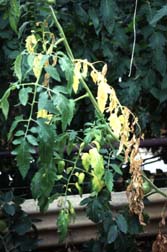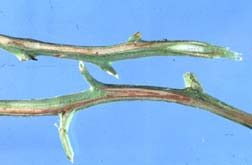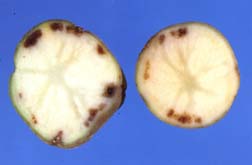
Several different species of Fusarium, a soil-borne fungus, cause wilting of watermelon, muskmelon, cucumber, squash, and other vine crops. In many cases the fungus-causing wilt in a particular crop is specific to that crop. These fungi are generally capable of surviving for long periods in the soil.
Symptoms
Wilting of older plants is often the first symptom of the disease. Before diseased plants totally collapse, however, they may begin to wilt during the hottest part of the day and recover during the night. Infected plants are often stunted and yellowed. Leaves often have dead areas which can mimic nutrient deficiencies. Stems of wilted plants when cut lengthwise at the soil line may show brown discoloration in the woody tissues immediately under the bark. Vines killed by Fusarium can be covered with pinkish-white fungal growth in wet weather.
Causal Organism
Fusarium oxysporum is well adapted to life in the soil. It can survive season to season in old diseased vines or it can live free in infested soil for many years in the absence of its host crop. The fungus grows at soil moisture and temperature favorable for vine crop growth. If the soil is very wet, infection is reduced. The fungus is stimulated to germinate when roots of susceptible host plants are growing nearby. It enters the plant through root tips or where some opening is present.
Control
- Plant wilt-resistant cultivars whenever possible. Degree of resistance is influenced by the populations of the fungi in the soil, and which races are present.
- Avoid introduction of the fungus into fields. Once soil is infested, crop rotation will be of little use because of the long-term survival of these fungi in soil. The fungus can be spread on equipment, tools, feet, and surface water contaminated with infested soil. Do not put compost on fields which has been made from diseased vines. Compost resulting from such piles will contain the fungus.
- Crop rotations of three to four years may be helpful in lowering the amount of Fusarium in the soil. Since the types of Fusarium-causing wilt in a crop are generally specific to that crop it is possible to rotate between vine crops in infested soil.
- In commercial production of vine crops, soil fumigation may be useful. For details see the Ohio Vegetable Production Guide (OSU Extension Bulletin 672).
Solanaceous crop plants (tomato, potato, pepper, and egg- plant) may be infected at any age by the fungi that cause Fusarium wilt and Verticillium wilt. The wilt organisms usually enter the plant through young roots and then grow into and up the water conducting vessels of the roots and stem. As the vessels are plugged and collapse, the water supply to the leaves is blocked. With a limited water supply, leaves begin to wilt on sunny days and recover at night. Wilting may first appear in the top of the plant or in the lower leaves. The process may continue until the entire plant is wilted, stunted, or dead. Tomato and potato plants may recover somewhat but are usually weak, unthrifty, and produce fruit of low quality. Peppers typically collapse rapidly and die. Fusarium and Verticillium wilts are rarely significant in field grown tomatoes due to the widespread incorporation in tomato cultivars of genes for resistance to the pathogen. However, the resurgent interest in planting "heirloom" tomato varieties which do not carry resistance genes has resulted in increased incidence of Fusarium and Verticillium wilts. Additionally, new races of both pathogens have been identified that are capable of overcoming the resistance in many popular tomato varieties. Verticillium race 2 is now common in tomatoes in Ohio, but its importance in reducing yield is not known at this time. There is very little genetic resistance available to either disease in pepper or eggplant.
Symptoms
Fusarium Wilt
Fusarium wilt symptoms begin in tomato and potato as slight vein clearing on outer leaflets and drooping of leaf petioles. Later the lower leaves wilt, turn yellow and die and the entire plant may be killed, often before the plant reaches maturity. In many cases a single shoot wilts before the rest of the plant shows symptoms or one side of the plant is affected first (Figure 1). If the main stem is cut, dark, chocolate-brown streaks may be seen running lengthwise through the stem (Figure 2). This discoloration often extends upward for some distance and is especially evident at the point where the petiole joins the stem. Potato tubers may show browning of the vascular ring (Figure 3) as well as browning at the stem end and decay where stolons are attached. In pepper, lower leaves do not begin to wilt until roots and the base of the stem have already started to decay. Wilting of the entire plant soon follows. Dark brown, sunken, and eventually girdling cankers may be seen at the base of the pepper plant. In eggplant, wilting progresses from lower to upper leaves, followed by collapse of the plant.
|

|

|
|
Figure 1. Fusarium wilt of tomato. Note yellowing and death of leaves on one side of the stem. |
Figure 2. Dark brown vascular discoloration in tomato caused by Fusarium wilt. Verticillium wilt causes a lighter tan discoloration of the vascular tissue. |
|

|
|
Management
- Because Fusarium fungi are widespread and persist several years in soil, a long crop rotation (4 to 6 years) is necessary to reduce populations of these fungi. Avoid using any solanaceous crop (potato, tomato, pepper, eggplant) in the rotation, and if Verticillium wilt is a problem, also avoid the use of strawberries and raspberries, which are highly susceptible. Rotate with cereals and grasses wherever possible.
- Keep rotational crops weed-free (there are many weeds hosts of Verticillium).
- Whenever practical, remove and destroy infested plant material after harvest.
- Maintain a high level of plant vigor with appropriate fertilization and irrigation, but do not over-irrigate, especially early in the season.
- If soils are severely infested, production of solanaceous crops may not be possible unless soil fumigation is an option. See the Ohio Vegetable Production Guide (OSU Extension Bulletin No. 672) for information on soil fumigation.
Fusarium wilt on melons vines causes the plant to wilt. The wilt is spread by the yellow and black striped cucumber beetle.
Fusarium wilt usually occurs on beans, peas, cabbage, sweet potatoes, tomatoes, and watermelon. The disease first causes the lower leaves to curl downwards. Then the leaves will yellow and the plant will become stunted. A cross section of the lower stem shows dark brown streaks running lengthwise.
Prevention:
Purchase wilt-resistant varieties of seeds and plants. Do not plant in a soil that has been infected by the disease. Crop rotation will naturally help.
Fusarium can be increased due to excessive nitrogen fertilization. A spray of phosphates and potassium can help control fusarium, and it can help. It also helps to lime the soil or media to reduce acidity of the media.
|